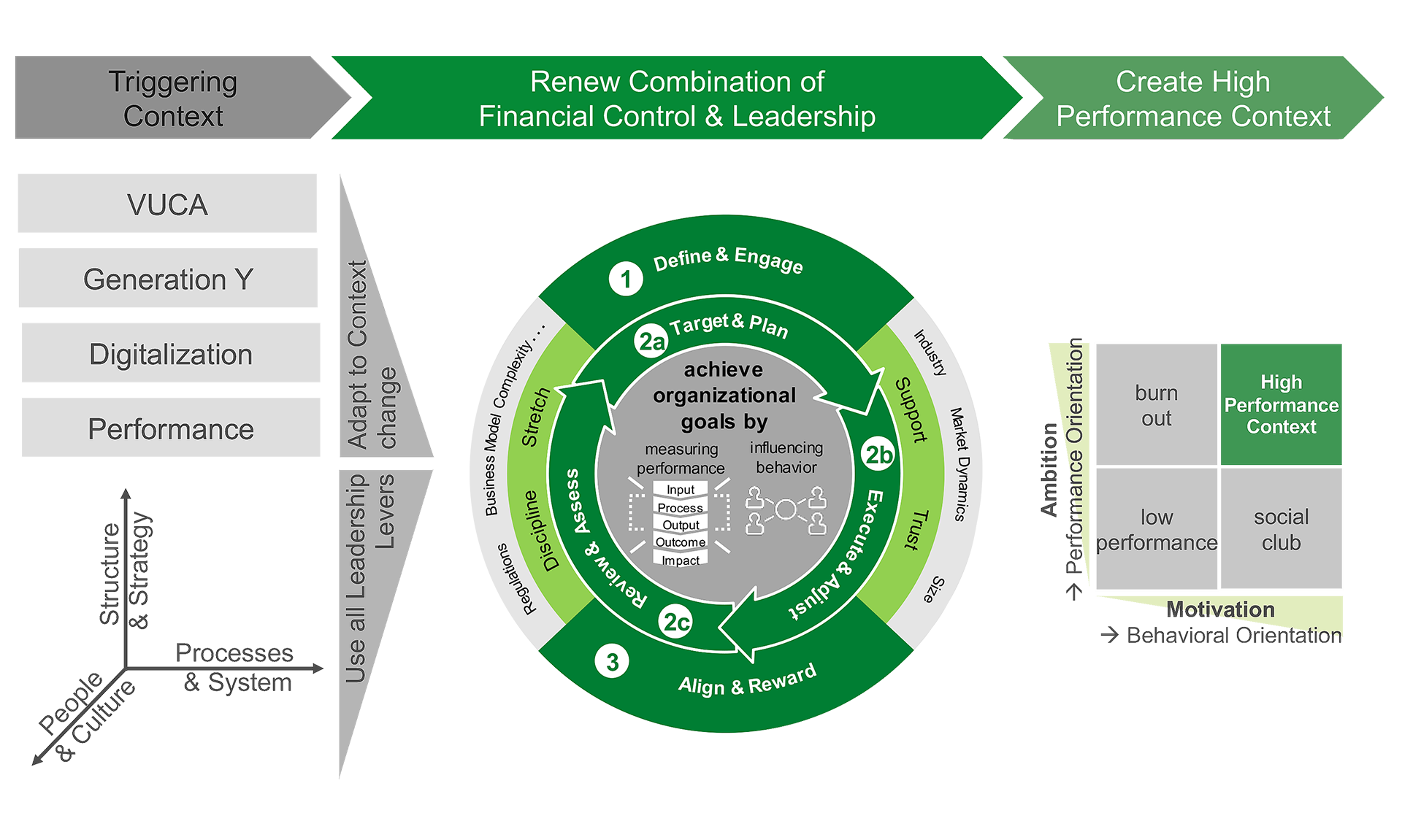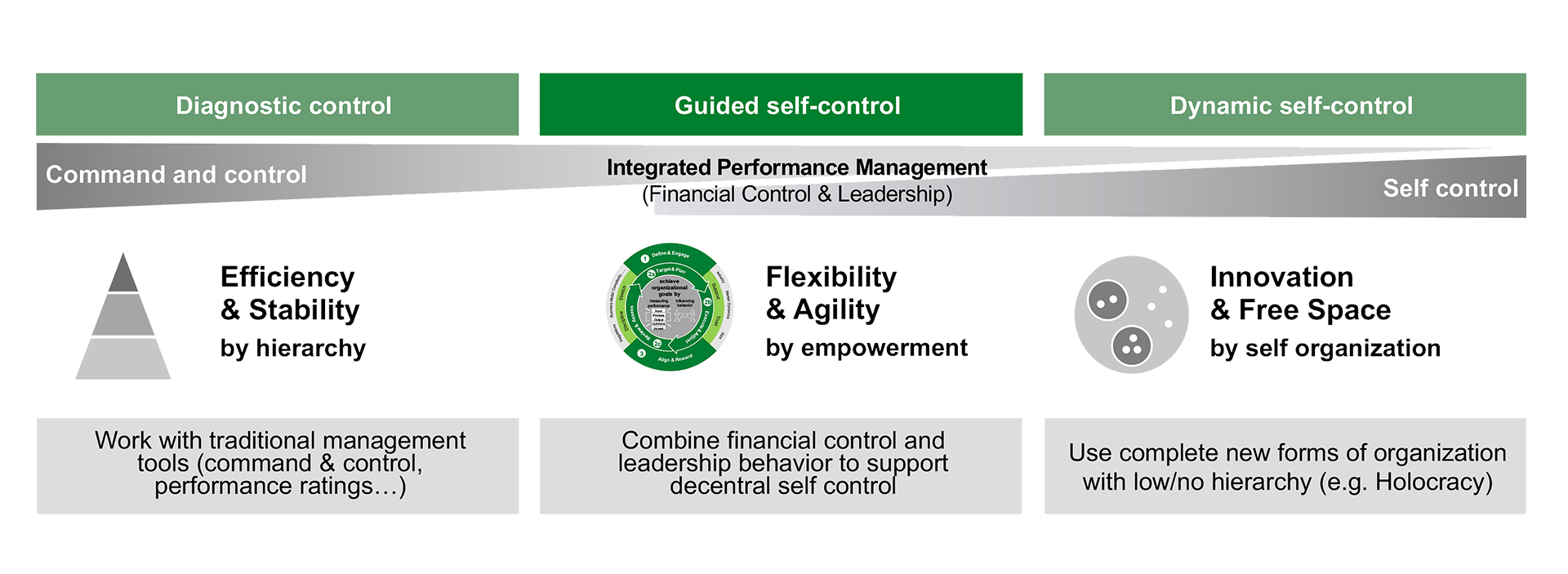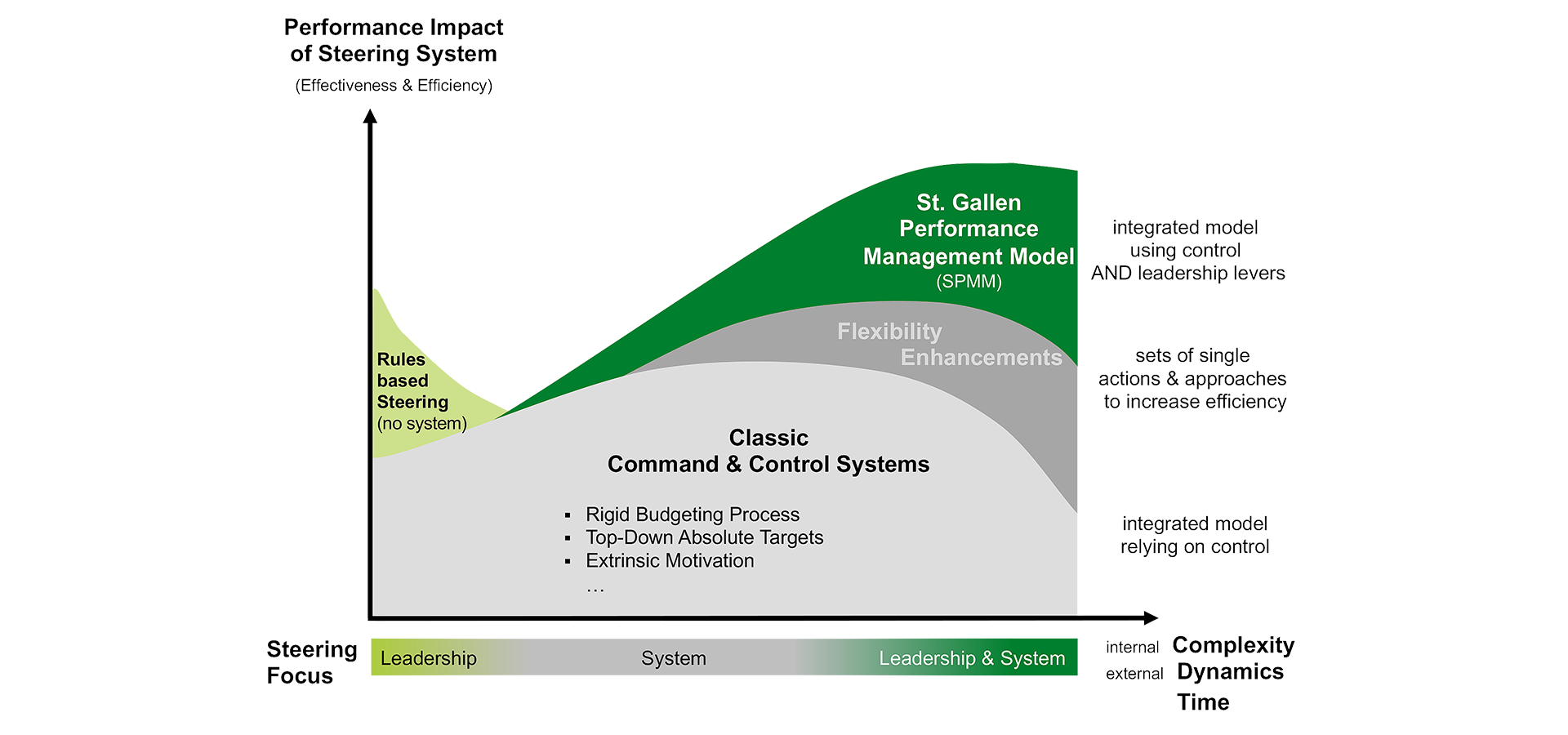
The SPMM - St. Gallen Performance Management Model is a holistic model for financial leadership and strategy implementation.
It is scientifically proven and successfully implemented in practice.
Performance management, understood as financial leadership and strategy implementation, has increasingly become a key success and differentiation factor for organisations. This is because organisations’ need to swiftly adapt to change has rendered industrial age management approaches such as command-and-control obsolete. A contemporary performance management approach requires the close alignment of financial control systems and leadership principles, as well as the replacement of the monetary-focussed, backward-looking command-and-control logic, based on analysing plan-actual deviations.
With the SPMM - St. Gallen Performance Management Model, we have developed and documented a holistic model since 2013 to align financial leadership with current challenges and to give academics and practitioners a concrete approach to solving them. It is the result of over 20 years of research and extensive practical experience at the Chair of Controlling/ Performance Management at the University of St. Gallen and the Hilti Lab for Integrated Performance Management.
With this information, we share our expertise with interested parties. As part of our innovation action research, we have inspired companies of different sizes and industries and have published several articles on the topic.
We are continuously improving our approach and look forward to feedback, suggestions, and conversations!
Most management approaches were developed during the industrial age. They are based on a traditional understanding of leadership characterised by the command-and-control principle and a strong focus on financial control parameters.
While such approaches promise success in stable environments, most companies face a very different reality:
an external environment dominated by a VUCA world (volatility, uncertainty, complexity and ambiguity)
requirements of working conditions and leadership styles are changing (generation Y, transformational leadership)
digitalisation is enabling and driving a fundamental shift in required management roles and tasks
performance is now defined more broadly – as a combination of financial success and social impact, with a clear reference to the organisation’s purpose.
Traditional control approaches focus on the process and system levels, neglecting behaviour-oriented, employee-oriented and strategic aspects. The SPMM includes all relevant levers to manage organisations by combining financial control and leadership practices in the form of management control packages.
Thus, we don’t refer to controlling, but to performance management, which – as a newly established discipline – brings together controlling and leadership, so as to be able to manage performance proactively and directly.
The foundation of purposeful performance management is a clear shared understanding of the organisation’s (financial and non-financial) goals. This requires a holistic performance measurement approach based on the input-process-output-outcome-impact model combined with leadership behavior.
To emphasise the action orientation, there is a process-oriented performance management cycle at the heart of the SPMM. We distinguish between fundamental system-building processes (1 and 3) and operational system-driving processes (2a, b, c).
The inner brackets illustrate the necessary balance of ambition and motivation in leadership. This is achieved by de-coupling target-setting and coordination as well as planning and performance evaluation. The outer bracket illustrates the necessity of incorporating the external context.

The five performance management process steps
It includes a clear definition of the organisation’s purpose, values and behavioural standards, as well as a strategy and a business model.
the strategic goals are operationalised and broken down into detailed subgoals and key initiatives.
It includes the performance creation, strategy execution and, if necessary, the adjustment of resource allocation.
It covers performance measurement and evaluation.
It is again carried out in longer intervals and at a more strategic level.
A key lever for effective transformation of an entire performance management system is the principle of guided self-control. In previous implementations, we identified key building blocks that have synergetic effects on the successful implementation
This includes clarity about the strategy, business model and key value drivers, as well as the application of specific control practices (relativity and flexibility) in target-setting. Thus, to structure financial targets, we follow the classification of the house of performance. We define flexible and relative targets in a top-down approach that includes the participation of the relevant manager.
This is about aligning goal-setting and compensation. The SPMM positions compensation primarily in terms of profit-sharing in the organisation’s success, linking it to the organisation’s performance progress. Research clearly shows that performance management via complex compensation systems is less important than good leadership practices – a core part of the SPMM.
Flexible, relative targets in the SPMM replaces the target-setting function of the traditional budgeting approach. Applying bottom-up rolling planning covers the remaining functions – forecasting and coordination.
Relative target-setting also requires changes to performance measurement and evaluation practices. Instead of a rigid evaluation based on plan-actual (budget-actual) comparisons, a measurement of actual-actual trends is combined with the dynamic measurement of relative targets against external or internal benchmarks.
Ultimately, since these principles and building blocks must fully live in the organisation, the instruments, behaviours and competences must be adequately documented and taught so as to enable sound business partnering and continuous organisational learning.

The SPMM focusses on a contemporary alignment of financial controls and leadership behaviours. Via guided self-control, the agility of the organisation and its employees increase, ensuring transparency and predictability of financial indicators and control instruments.
Thus, the SPMM focusses on the organisational level, with strong links to and demands of the individual behavioural level. The SPMM seeks to shape the future role of the financial organisation towards business partnering. It focusses on the how and where in decision-making and strategy implementation rather than on the change in (organisational) structure or the introduction of a completely new instruments set.
Organisational design research and practice focusses on innovative approaches (autonomous or network organisations, holacracy, etc.). During research projects and stays in the U.S. and Asia, we intensively examined the implementation of such innovative approaches in leading corporations (including Google and Groupon). These approaches give new and especially fast-growing organisations enormous flexibility via strong reliance on self-control. In our view, this is not an option for most established organisations. Nonetheless, the rigidity and slowness of traditional systems based on external control must be avoided. Thus, the SPMM is positioned between these two extremes, and proposes the notion of guided self-control.
In both academic research and practical application, we are concerned with the finance function’s future. In such a future-oriented long-term perspective, the SPMM serves as guidance and target operating model, also concerning organisational design. This includes the division of labour in the performance management function and its interaction with other functions in the universe of CFO, CEO and further support functions.
Within performance management, we assume a division into four roles:
system design and further development
(system) application (via a shared service centre and analytics)
business partnering
culture and transformation
At the organisational level, we expect a convergence of support functions, such as finance, governance/risk/compliance, HR, IT and, eventually, procurement. In this context, the performance management function acts as a key driver in reaching the goals of the organisation as a whole ( = performance).

The SPMM does not claim to be the best management system in every situation. In both research and application, it is well known that in small organisations or low-dynamics, rules-based and person-centred management is a very effective way to manage.
However, when complexity increases, most organisations adopt classical management systems that follow a traditional command-and-control scheme; in other words, a clear division between instruction and execution. With a further increase in (internal organisational) complexity, and a simultaneous increase in (external market) dynamics, such systems’ inertia increasingly negatively impacts on performance. Organisations usually react to this with various attempts to increase the management system’s flexibility without changing the underlying management paradigm.
The SPMM provides an alternative design by integrating insights from behavioural research and theory into the design of control practices.
Based on the principle trust equals speed, a trust-based culture is at the centre, which – in combination with specific goal-setting mechanisms and decentralised self-control practices – is much more flexible and agile. The SPMM can have significant effects, especially in situations with high complexity and dynamics, and can significantly increase a company’s management effectiveness.
The SPMM’s application is not limited to specific industries or organisational sizes. Our experience shows that its effects are particularly noticeable in medium-sized and large corporations. We have successfully implemented the SPMM in many organisations, including Hilti. These organisations’ effectiveness and efficiency have increased substantially, which has also led to significant increases in financial performance. Firms that use SPMM practices more intensely perform much better in terms of both financial performance as well as employee and customer satisfaction compared to companies with a more traditional management approach.

With the SPMM, we theoretically and conceptually contribute to the further development of management systems, applying this knowledge in practice and continuously learn from these implementations.
Similar to Prof. Robert Kaplan, who developed the Balanced Scorecard by relying on innovation action research, we are applying this method to continuously improve the SPMM by combining three perspectives.
Academic research and further developments are carried out at the Chair of Controlling / Performance Managementand the Hilti Lab for Integrated Performance Management at the University of St. Gallen.
There we carry out specific research projects mostly in the context of Dissertations, Bachelor and Master theses. By examining specific aspects through the application of rigorous scientific methods, we have established a solid theoretical foundation for the SPMM and continuously contribute to the academic discussions via academic and applied publications.
The most current description is the one you are now reading here on the website, which we continuously maintain and update. Individual aspects and previous versions are documented in the following publications.
Discover Publications
A core organizational practice for implementing the SPMM is clarity about strategy, targets, and results. For financial performance measurement and management, we apply the “house of performance”. It uses the three dimensions Growth, Profitability, and Capital Efficiency, as well as other components like RoCE and Economic Profit. In our education, in target setting and benchmarking approaches as well as in transfer activities we use an IT application, the “HPC" (House of Performance Cockpit).

We regularly conduct training and executive talks on the SPMM
We teach the SPMM as an example of a contemporary performance management framework at Bachelor and Master programs at the University of St. Gallen. Also in executive programs of the University of St. Gallen (EMBA and others) the SPMM is an important part. With our Performance Management Academy we offer a range of courses for different management audiences from finance specialists to non-finance executives and board members.
The most extensive program is our Certificate of Advanced Studies (CAS) “Performance Management intensive” in 9 two-day-modules, which gives an overview of the SPMM and deep dives for different aspects (strategy, financials, planning, leadership etc.).
There we cover state of the art of performance management as well as innovative practices like Objectives & Key Results (OKRs), automated forecasting, driver based planning and simulation etc. The two-day-modules and courses for specific target groups (non-finance executives, board members etc.) can be booked also individually to better meet specific needs and interests.
We rely on interactive teaching methods, incorporating individualized formats like e.g. “bring your case”. There participants describe an actual challenge in their position and together with faculty and the other participants we debate and develop individualized solution with real value added. Thus we carefully select participants from industry with sound leadership experience.
The SPMM was developed at the Chair of Controlling / Performance Management and the Hilti Lab for Integrated Performance Management at the University of St. Gallen. As part of the Institute of Accounting, Control and Auditing, our research, teaching, and knowledge transfer focus on performance management and business analytics.
University of St. Gallen
Institute for Accounting, Control and Auditing
Chair of Controlling / Performance Management
Prof. Dr. Klaus Möller
Tigerbergstrasse 9
CH-9000 St. Gallen